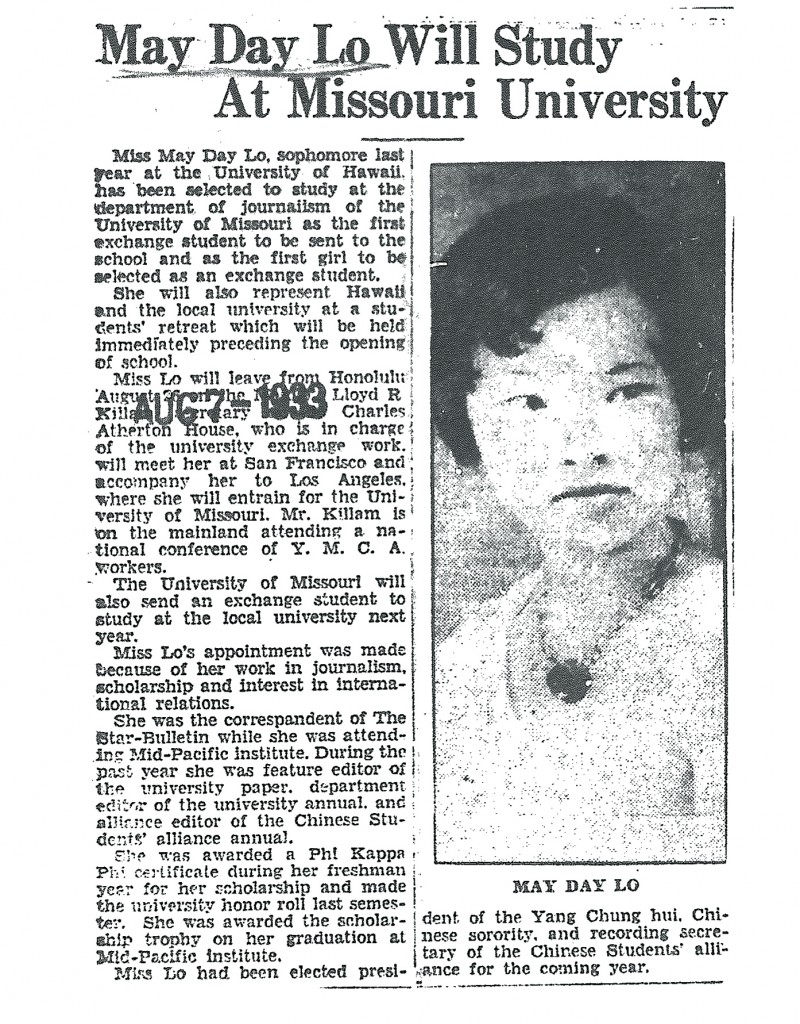Upcoming Screenings:
no event
Follow us on Facebook
HELP BRING FINDING KUKAN TO CLASSROOMS
Sign up for our mailing list.
Tag Archives: Hawaii
The Power of the Press: Part 1– May Day Lo
A blog in support of FINDING KUKAN’s 10K in 10weeks “Keep This Film Alive Campaign”.
In the Lily Wu detective novels by Juanita Sheridan one of the colorful sidekicks is a female reporter named Steve (Stephanie Dugan) who funnels information to her two amateur detective friends Lily and Janice. Since many of her fictional characters are based on real life people, I wondered if Sheridan based Steve on some of the ballsy female reporters who were breaking into newsrooms in the 1930s. So my ears pricked when I heard that Li Ling-Ai had a journalist friend in the 30s and 40s named May Day Lo. Yes, that is her real name, and no she was not even born in May.
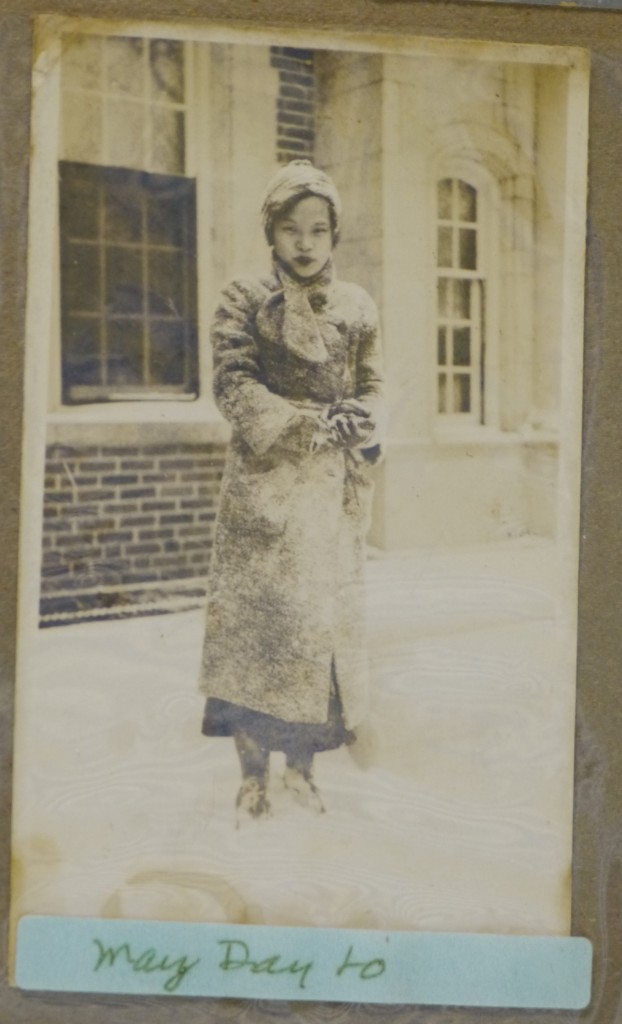
May Day Lo at the University of Missouri (photo courtesy Susan Cummings)
In the mid 1930s May Day Lo made history by being one of the first Asian American women hired to report for a major daily newspaper. The progressive Honolulu Star-Bulletin hired Lo and Ah Jook Ku after they graduated from the University of Missouri Journalism School. May Day Lo also broke ground at Journalism School by being the first “exchange student” accepted there (remember, Hawaii was still a territory and not officially part of the United States).
Notably, in 2010 when the Asian American Journalists Association put together a list of pioneering Asian journalists, a majority of them were from Hawaii. AAJA historian Chris Chow commented, “Hawaii was more open to multiculturalism. There was recognition that this is an important market and you’d better well serve them (Asian-Americans) if you want to make any money.”
Back in the 30’s, the Star Bulletin seemed to cover stories about local Asians more comprehensively than the rival Honolulu Advertiser. And May Day Lo’s byline was on several early articles written about Li Ling-Ai, including the one that probably prompted Advertiser reporter Rey Scott to call Li Ling-Ai into his office for an interview on that fateful night in 1937 when plans for making KUKAN were first hatched.
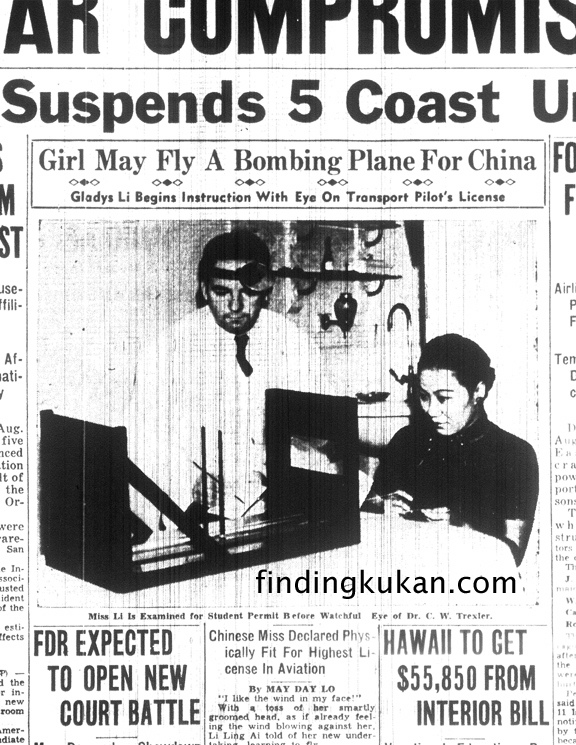
Reporter May Day Lo gives front page coverage to fellow Chinese American pioneer — Li Ling-Ai (aka Gladys Li)
I love knowing that a petite Chinese woman who was raised by a reverend in Hilo was the first exchange student at the prestigious University of Missouri School of Journalism and that the power of her pen brought attention to another pioneering Chinese young woman in a way that changed her life forever. I wanted to find out more about May Day Lo, especially when I found an intriguing letter from her to Li Ling-Ai:
July 31, 1941,
Dear Li Ling Ai,
Now that I am home again, it all seems like a dream that I met you and all the others in New York and had such a wonderful time…. Please give my Aloha to Mrs. James Young, Rey Scott and Mr. Ripley when you see them.
May Day Lo had been in New York right around the time when KUKAN premiered at the World Theater just off Broadway! She had met both Rey Scott and Robert Ripley – two key players in Li Ling-Ai’s life at the time. Could May Day hold clues to some of the unsolved mysteries surrounding KUKAN?
Unfortunately May Day had died in a tragic car accident in 1986. May Lee Chung, editor of the ACUW publication that documents so many pioneering Chinese women’s lives (see other posts about this “Orange Bible”), could remember clearly the circumstances of May Day’s death. But she did not know what had become of May Day’s only child David, someone who might be able to tell me more. The trail remained cold until the Power of the Press struck again in 2011. Stay tuned…
Support our 10K in 10 Weeks campaign by clicking the red button. 
(As of 9/6/13 we have raised $5,025 and have $4,975 more to raise by 10/15/13)
Soo Yong – Another Chinese Woman We Should Know More About – Part 2
A blog in support of FINDING KUKAN’s 10K in 10weeks “Keep This Film Alive Campaign”.
A family story often told about Soo Yong (born Ahee Young) is that when she was four or five years old her father became gravely ill and summoned the family to hear his last words. But Ahee was missing. The family searched all over for her. They finally found her in Wailuku town. She was completely mesmerized by the performance of a Chinese opera troupe who had come to town. This is Soo Yong’s earliest dramatic memory.
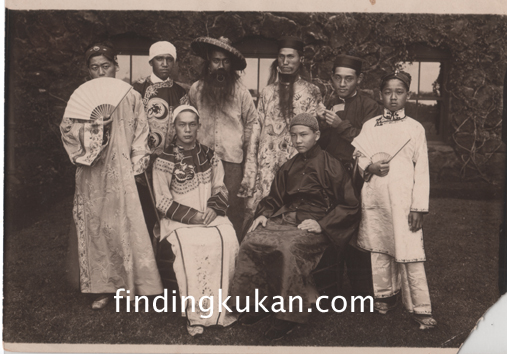
Chinese Opera Performers in Hawaii
Si it must have been a dream come true for Soo Yong when in 1930, at 28 years of age, she was chosen to accompany the most famous Chinese opera star of all time on a six-month tour of America.
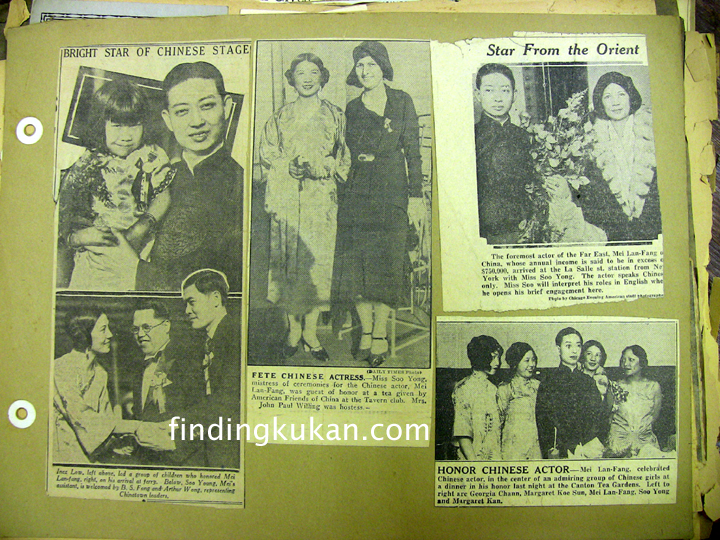
Soo Yong acts as Mistress of Ceremonies for Mei Lanfang’s 1930 tour of America
Mei Lanfang was also idolized by Li Ling-Ai whose dramatic interests were stirred up by Chinese opera performances her father took her to when she was a young girl. During his 1930 tour Mei stopped in Honolulu and Li Ling-Ai had a chance to meet him.
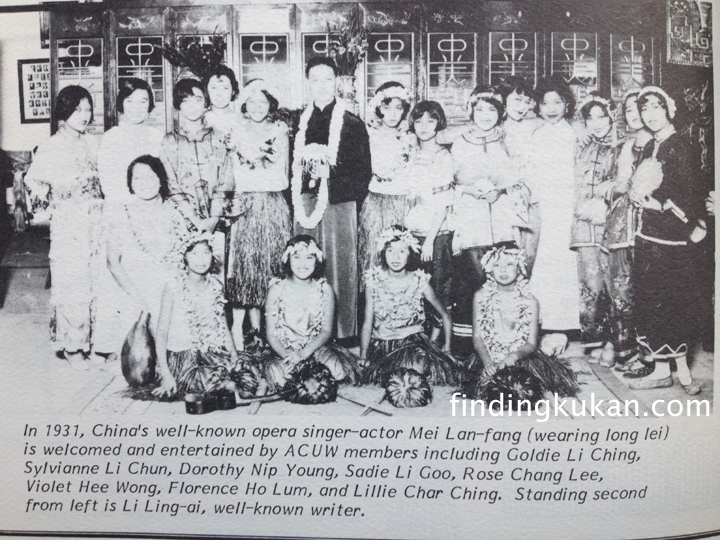
Photo from the ACUW publication TRADITIONS FOR LIVING
A year or so later Li Ling-Ai left on her second trip to China and told newspaper reporters she intended to study with the great man – a lofty goal for a recent graduate of the University of Hawaii. I wondered if Soo Yong’s insider position emboldened Li Ling-Ai to approach the great Mei for lessons.
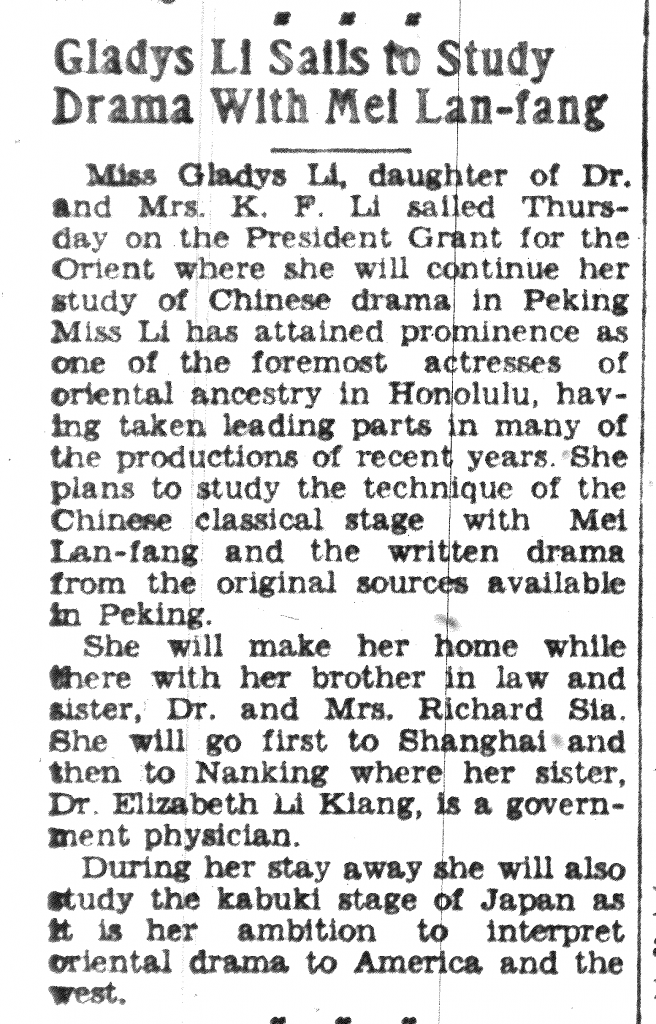
Honolulu Star Bulletin Article from August 6, 1932
I found no subsequent mention of Li Ling-Ai studying with Mei Lanfang. But several biographies of Li state that she studied privately with the famous dancer Chu Kuei Fang. It was hard to find any mention of Chu Kuei Fang on the internet and I began to doubt Li Ling-Ai’s claims. But in Soo Yong’s personal scrapbook that was donated to the University of Hawaii, I discovered Chu listed as a performer in a 1930 program for Mei Lanfang’s tour.
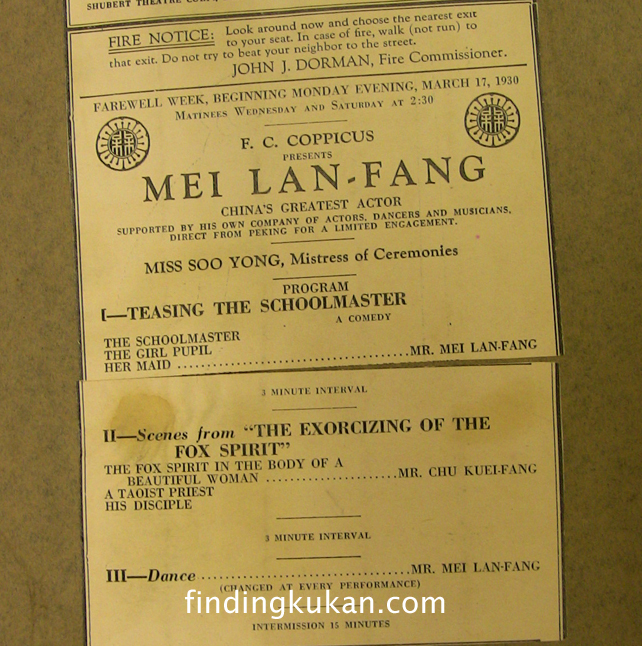
Chu Kue-Fang performs on the same program as Mei Lanfang
Chu must have been very accomplished to share stage time with the great Mei Lanfang. I wonder if this old photo, found amongst Li Ling-Ai’s possessions, is of Chu Kuei Fang. If anyone can positively identify the man in the photo, please let me know.
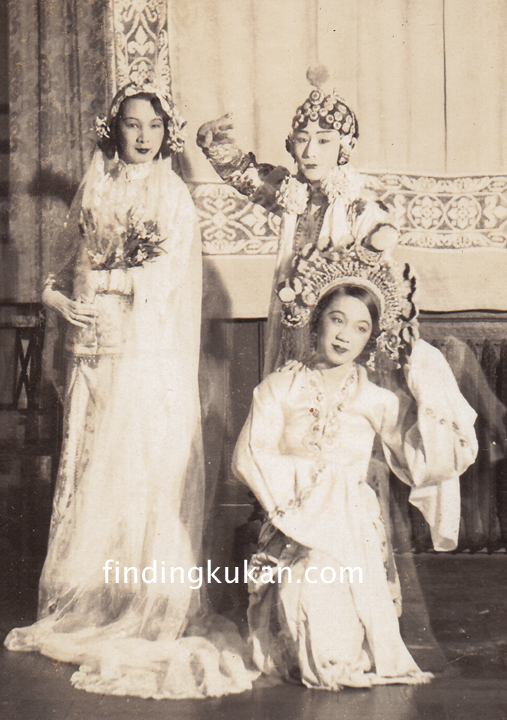
Could the man behind Li Ling-Ai be Chu Kuei-Fang?
Soo Yong and Li Ling-Ai also shared a passion for helping their Chinese homeland during the Japanese invasion of the country. As early as 1937 Soo Yong was performing in benefits to aid Chinese refugees.
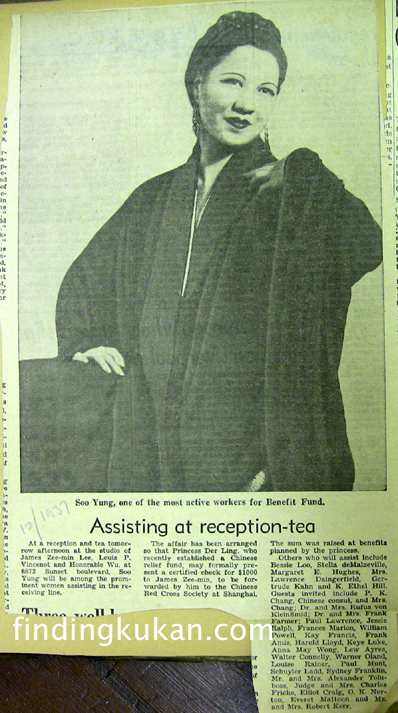
December 1937 Soo Yong hosts tea for China Relief
1937 was also the year that Li Ling-Ai sent Rey Scott to China so that the story of the people of China could be told in photographs and film – the film would eventually become KUKAN. Whether Soo Yong was a role model for Li Ling-Ai or simply another extraordinary Chinese woman who became a political activist when war came we might never know. But one thing’s for certain — we should definitely know more about her than we do.
Soo Yong: Another Chinese Woman We Should Know More About — Part I
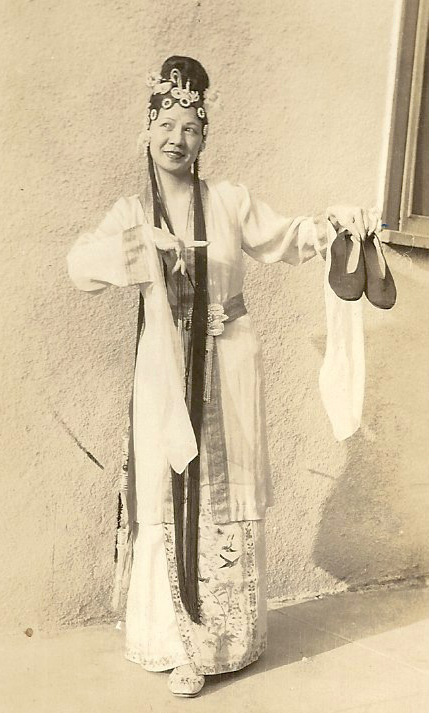
Could the Chinese American actress Soo Yong have been an inspiration for the fictional Lily Wu? (photo courtesy of Barbara Wong)
I’m starting a 10-week blog-a-thon in support of our 10K in 10weeks “Keep This Film Alive Campaign”. The goal: get us back into the edit room on October 15 to finish a rough cut of FINDING KUKAN. What better way to kick off that effort than to re-visit my search for LILY WU – the fictional detective created by author Juanita Sheridan. According to Lily’s friend and Watson-like companion Janice Cameron, “Lily is a chameleon. She can change effortlessly into whatever character the occasion requires…” Lily is also smarter, sexier and more worldly than most of the Caucasian characters she runs into.
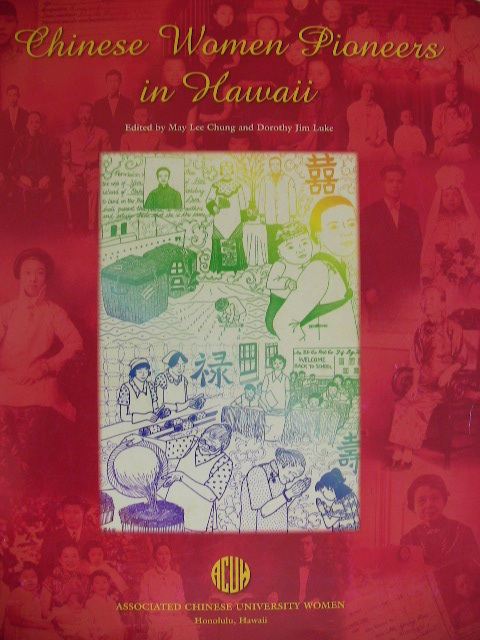
This book, published by the Associated Chinese University Women of Hawaii, is a wonderful collection of short bios
While trying to locate the real life inspirations for Lily Wu I recall poring over what I now think of as THE ORANGE BIBLE (see photo above) and stopping short at the entry for Soo Yong. Why? Because Soo Yong was a Chinese movie star from Hawaii! She appeared glamorous and gutsy, running away from a restrictive small town life in Wailuku, Maui for the more cosmopolitan Honolulu where she put herself through school at the University of Hawaii and then Columbia University in NYC. She was just the kind of woman who might have inspired Juanita Sheridan to create Lily Wu. But my interest in Soo Yong tailed off when I discovered that Soo Yong had left Hawaii before Juanita Sheridan arrived there, making it unlikely that the two women were friends.
My interest in Soo Yong was re-ignited when Li Ling-Ai’s sole surviving sister mentioned that Ling-Ai had spent time in Hollywood and had been friendly with a Chinese actress from Maui. Sure enough, a keyword search through the Los Angeles Times brought up a 1936 article placing Soo Yong and Li Ling-Ai together in Hollywood:
“East is east and west is west, and the two of them met last Tuesday afternoon at Joine Alderman’s Salon. The east was personified by a lovely Chinese lady whose name and voice are poetry itself, Li Ling Ai. Clad in her native black satin robes, embroidered in gold and silver and shining colors, she told the forty or so debs who comprise the salon about her native country. … And her words about the beauties of Pekin and her studies in ancient philosophy were translated to the debs by another Chinese-robed lady, Soo Yung.”
The gossip column inaccurately assumed that Ling-Ai could not speak English and Soo Yong was there merely as a translator, but it whetted my appetite to learn more about Soo Yong. Could she have been a mentor or role model for Li Ling-Ai?
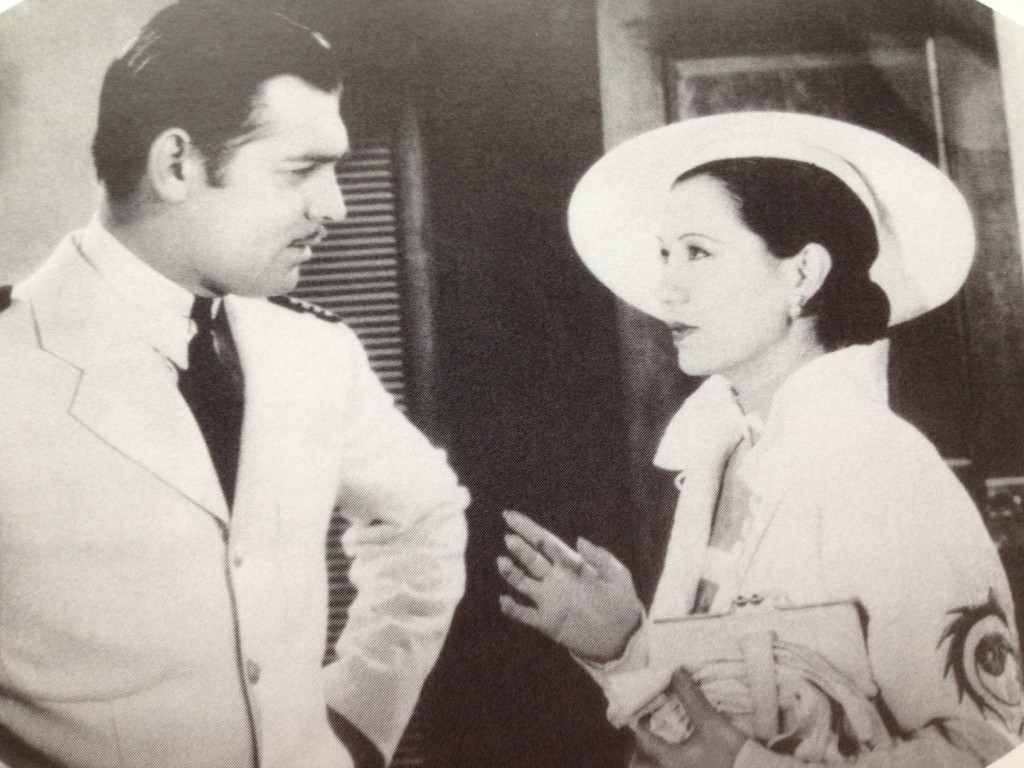
Clark Gable and Soo Yong in The China Seas
Being an old movie nut, one of the first things I did was rent one of the Clark Gable movies Soo Yong had been in, China Seas. Although the movie depicts most Chinese in stereotypical coolie roles, Soo Yong convincingly plays a high-brow Chinese aristocrat who out-classes Gable’s ex-girlfriend played by Jean Harlow. This small 1935 role would lead to Yong playing two parts in the 1937 hit The Good Earth. She was also Jack Soo’s mother in Flower Drum Song and had supporting roles in Soldier of Fortune with Clark Gable, Peking Express with Joseph Cotton, and Love is a Many Splendored Thing with Jennifer Jones. Why we don’t know much about her may be because she was never able to have a full-fledged Hollywood movie career.
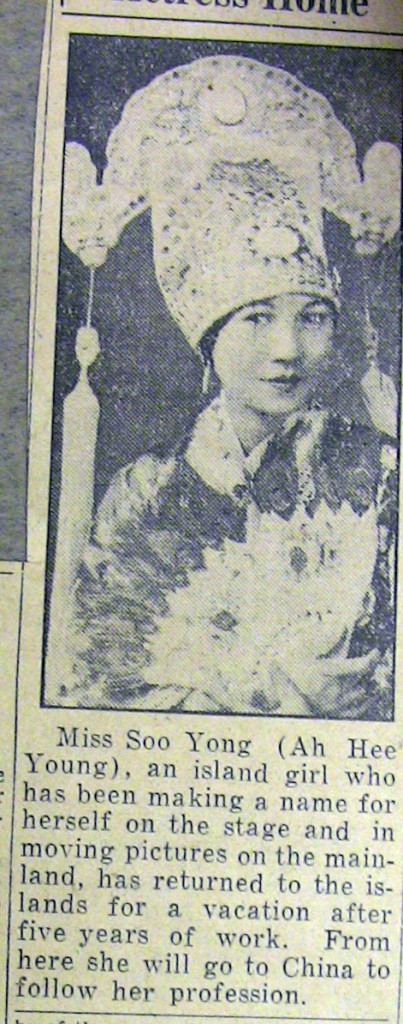
In 1935 Soo Yong advised islanders that Asians have “A Chinaman’s Chance” of breaking into Hollywood.
In the 1930s Soo Yong was interviewed by Loui Leong Hop for the Honolulu Star-Bulletin:
“When asked about the possibility for local-born orientals to break into the talkies, she simply said, “A Chinese has a Chinaman’s Chance.” Explaining further on this point Miss Young stated that at present the Hollywood studios are name crazed. If there’s a production which required an oriental to play the part, the Hollywood producers would invariably select one of their more famous actors or actresses.”
Unfortunately not much has changed in Hollywood, and Asians still struggle to find starring roles on the big screen.
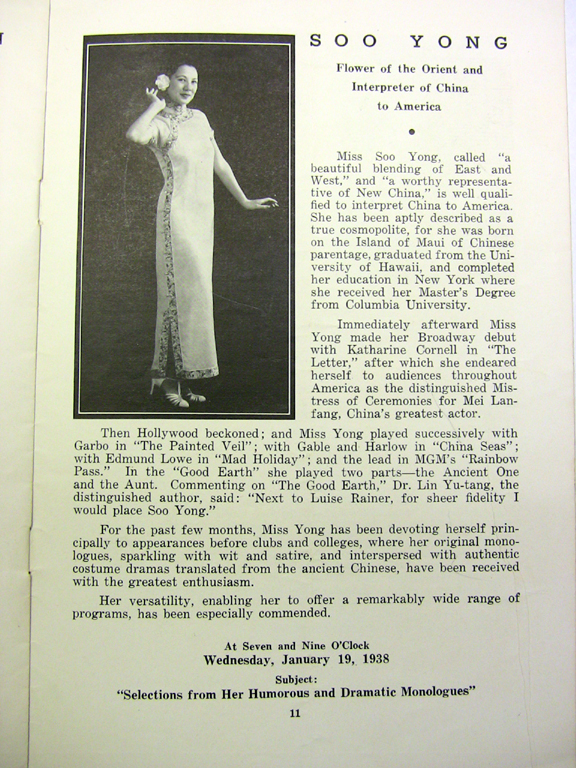
Soo Yong, Interpreter of China to America
Soo Yong would eventually make a living on the lecture circuit, performing entertaining Chinese monologues to educate audiences around the country about Chinese culture. As of this date Soo Yong does not even have a Wikipedia page, but we should definitely know more about this pioneering Chinese American actress. Stay tuned for part two of this blog where I’ll write about some amazing discoveries I found in Soo Yong’s personal scrapbook.
Support our 10K in 10 Weeks campaign by clicking the red button. 

